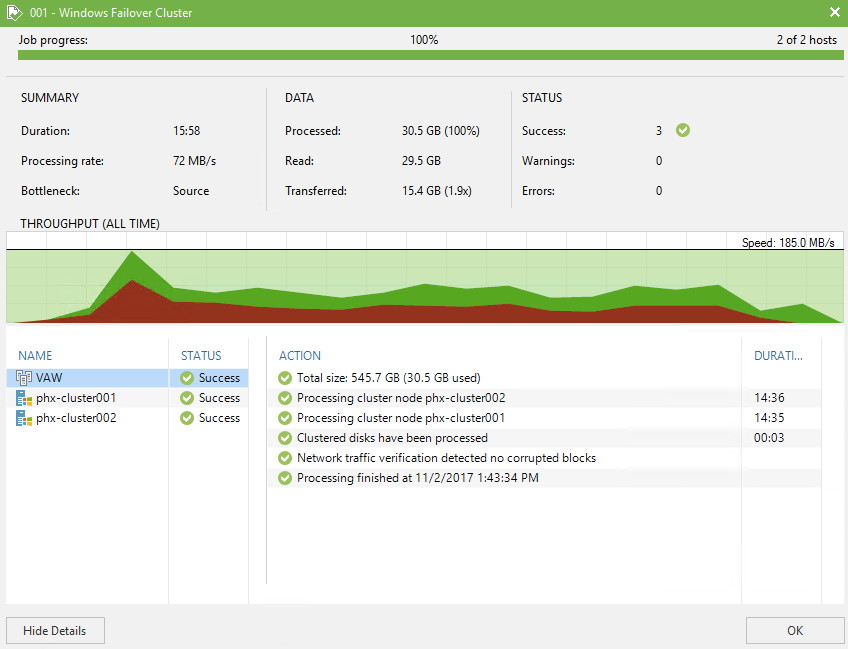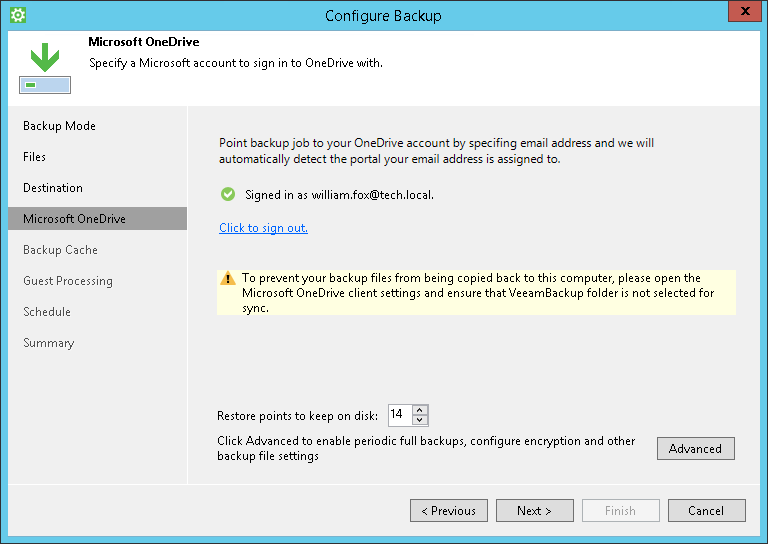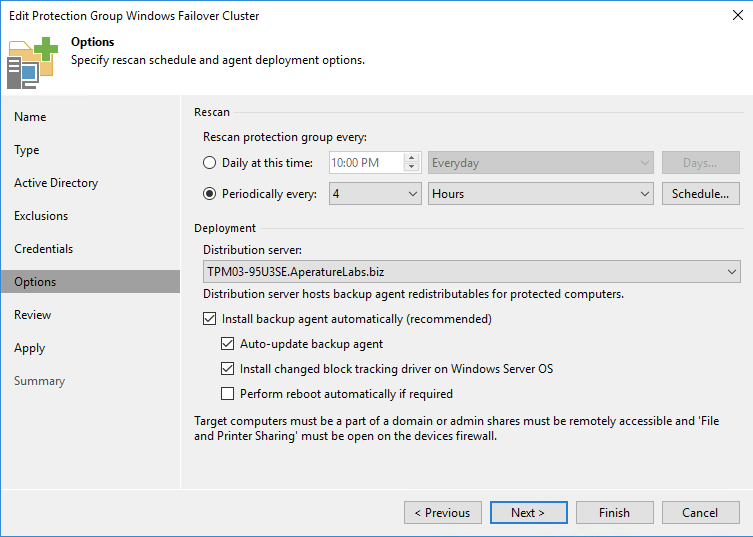Veeam Agent for Microsoft Windows Overview: Version 2.1
Along with Veeam Backup & Replication 9.5 Update 3, new versions of Veeam Agent for Windows and Linux were released. These backup solutions for physical machines can now work both autonomously and centrally under the control of Veeam backup server. Today I will talk a little about the new features of Veeam Agent for Microsoft Windows , which were not covered in a previous post . For sim welcome under cat.

Veeam Agent for Microsoft Windows version 2.1 can backup to Microsoft OneDrive cloud storage using personal or corporate (OneDrive for Business) accounting.
Backup in OneDrive has the following implementation features:
Important! In this version, backup in OneDrive is available only for agents working autonomously (that is, not under the control of Veeam Backup & Replication).
In addition, if you decide that the standalone Veeam Agent should start working under the control of Veeam Backup & Replication at some point, then it will be impossible to import backups created by this agent in OneDrive into the console during offline operation.
To back up to cloud storage, you need to select the appropriate options in the backup configuration wizard:
You can also restore the machine or the necessary files from a backup stored on OneDrive (supported only for paid licenses).
There are several restrictions on functionality, for example:
More information about all this is described in the user manual (in English).
By default, Veeam Agent uses a built-in mechanism for tracking changed blocks. Briefly, his work is illustrated by this picture:

If it is not possible to identify which files have changed (for example, a digest from the backup file has not been received), then you have to read all the blocks, which can significantly slow down the backup. This mechanism only works for NTFS volumes.
In the new version of Veeam Agent for Microsoft Windows , another mechanism is implemented - the Veeam Change Block Tracking Driver (Veeam CBT Driver), which can work with NTFS, FAT and ReFS file systems. The driver helps speed up incremental backup of machines where applications work with large databases.
Important! Veeam CBT Driver is designed for server versions of Windows and works with a paid Server license .
If such a driver is used, then data on the changed blocks are recorded in specially designed files with the extension .VCT. These files are stored on the machine where Veeam Agent is running, in the folder C: \ ProgramData \ Veeam \ EndpointData \ CtStore .
During the backup job, Veeam Agent uses these files to retrieve information about the changed blocks and copy only them. CBT data can be "flushed" as described here .
In a scenario with centralized agent management:
In a stand-alone agent scenario:

Note: For the Veeam CBT driver to work on a machine running Windows Server 2008 R2, you must install the Windows update KB3033929 on the machine.
Read more about the CBT driver here .
Veeam Agent can work with the following versions:
Note: If the agent is running Veeam Backup & Replication, it will also support Windows Server failover clusters, SQL Server failover clusters, and SQL Server Always-On Availability Groups (including for SQL Server 2017).


Back up to Microsoft OneDrive
Veeam Agent for Microsoft Windows version 2.1 can backup to Microsoft OneDrive cloud storage using personal or corporate (OneDrive for Business) accounting.
Backup in OneDrive has the following implementation features:
- Free version of Veeam Agent only supports backup of system status
- the paid version supports both backup of the entire machine, and backup at the file level
- backup of server versions of Windows is not yet supported (you can have a Server license , but it must be on a machine with a desktop OS)
Important! In this version, backup in OneDrive is available only for agents working autonomously (that is, not under the control of Veeam Backup & Replication).
In addition, if you decide that the standalone Veeam Agent should start working under the control of Veeam Backup & Replication at some point, then it will be impossible to import backups created by this agent in OneDrive into the console during offline operation.
To back up to cloud storage, you need to select the appropriate options in the backup configuration wizard:
- In the Destination step, select Microsoft OneDrive .
- In the next step, click Click to sign in to Microsoft OneDrive , in the browser window, enter the Microsoft account with which we will connect to OneDrive, and click Sign in .
- If you need to use another account, click Click to sign out and set a new one.
Note: If you have configured synchronization of OneDrive and folders on the local machine, it is highly recommended to exclude the VeeamBackup folder from this process (this can be done by going to the OneDrive client). If this is not done, then the backups will also be on the local machine, taking up space on it.
- Set storage policy:
- For Free and Workstation licenses, you will need to specify how many days to store backups, counting from the moment you last used the machine.
- For the Server license, you will need to specify how many recovery points need to be stored, counting from the last created point.
- We go through the steps of the wizard to completion.
You can also restore the machine or the necessary files from a backup stored on OneDrive (supported only for paid licenses).
There are several restrictions on functionality, for example:
- You cannot create a separate full backup in OneDrive (always only a chain)
- SQL and Oracle database transaction logs not supported on OneDrive
More information about all this is described in the user manual (in English).
Choice of CBT mechanism (for servers)
By default, Veeam Agent uses a built-in mechanism for tracking changed blocks. Briefly, his work is illustrated by this picture:

- When creating a full backup, Veeam reads the Master File Table (MFT) of the volume whose backup is running. A digest with file system metadata is created based on the entries in this table. Veeam transfers these digests to the backup storage location and writes them to the backup file.
- When creating an Veeam incremental backup:
- Reads the Master File Table (MFT) of the volume whose backup is running, and creates a new digest with metadata.
- Gets digests from the backup created during the previous session.
- Compares them with a new digest, identifying files whose blocks have changed from the previous session.
- Reads only blocks related to these files from a VSS snapshot.
If it is not possible to identify which files have changed (for example, a digest from the backup file has not been received), then you have to read all the blocks, which can significantly slow down the backup. This mechanism only works for NTFS volumes.
In the new version of Veeam Agent for Microsoft Windows , another mechanism is implemented - the Veeam Change Block Tracking Driver (Veeam CBT Driver), which can work with NTFS, FAT and ReFS file systems. The driver helps speed up incremental backup of machines where applications work with large databases.
Important! Veeam CBT Driver is designed for server versions of Windows and works with a paid Server license .
If such a driver is used, then data on the changed blocks are recorded in specially designed files with the extension .VCT. These files are stored on the machine where Veeam Agent is running, in the folder C: \ ProgramData \ Veeam \ EndpointData \ CtStore .
During the backup job, Veeam Agent uses these files to retrieve information about the changed blocks and copy only them. CBT data can be "flushed" as described here .
Driver installation
In a scenario with centralized agent management:
- in the Options step of the protection group configuration wizard, select the Install changed block tracking driver on Windows Server OS option

- or in the Veeam Backup & Replication console, select the desired server in the Inventory view and click Install driver for it

In a stand-alone agent scenario:
- open the management console, go to the Settings tab and click Install CBT driver .
- To complete the installation, you will need to restart the machine.

Note: For the Veeam CBT driver to work on a machine running Windows Server 2008 R2, you must install the Windows update KB3033929 on the machine.
Read more about the CBT driver here .
Support for new versions of Windows and SQL Server
Veeam Agent can work with the following versions:
- Windows 10 Fall Creators Update
- Windows Server 2016 version 1709
- Microsoft SQL Server 2017
Note: If the agent is running Veeam Backup & Replication, it will also support Windows Server failover clusters, SQL Server failover clusters, and SQL Server Always-On Availability Groups (including for SQL Server 2017).

